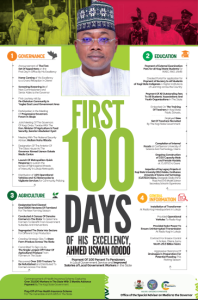By Uche Nnadozie
By all metrics of development, Lagos is a complex and demanding city to govern. Its population surges daily, its terrain challenges engineers, and its transportation needs test the limits of logistics and leadership.
Yet, in the last six years, Governor Babajide Sanwo-Olu has turned this dynamic metropolis into a living laboratory of transformational infrastructure — earning him well-deserved accolades as a revolutionary in modern urban mobility.
As he marks his 60th birthday, it is fitting to celebrate not just his age but his astonishing achievements — particularly his groundbreaking strides in roads, bridges, water, and rail transport.
It is no exaggeration to say that Sanwo-Olu has rewritten the transportation narrative of Lagos. From the mainland to the island, from Badagry to Epe, his administration has built or rehabilitated over 60 major roads and more than five critical bridges. Between May 2024 and May 2025 — despite national economic headwinds and global inflation — Sanwo-Olu’s government didn’t merely stay afloat; it surged ahead. That alone is a testament to both vision and willpower.
What distinguishes his approach is not just scale, but strategic intent. The governor’s emphasis on connectivity — linking remote communities to urban centres, integrating industrial corridors with arterial roads — is as deliberate as it is visionary.
The Abiola-Onijemo Link Road and Bridge in Ifako-Ijaiye, the Babafemi Dada Road network in Alimosho, the Oyinkan Abayomi and Macpherson upgrades in Ikoyi, and the newly completed pedestrian bridge at Alapere all contribute to easing commute times, stimulating local economies, and improving urban livability.
His rehabilitation agenda is equally robust. From Oduduwa Crescent to Sasegbọn Street in Ikeja, and from Iwaya Road in Lagos Mainland to Navy Town in Amuwo-Odofin, the story is one of consistent renewal.
Even roads awaiting commissioning — such as the Magbon-Alade Township Roads in Ibeju-Lekki and the Toga Road in Badagry — reflect a proactive and forward-thinking rollout plan that anticipates population growth and urban sprawl.
But perhaps no legacy project better defines Sanwo-Olu’s tenure than his relentless push for urban rail. For decades, Lagosians dreamed of a functional metro system. Under Sanwo-Olu, that dream finally materialised. The completion and launch of the Blue Line — from Marina to Mile 2 — was a historic turning point for Nigeria’s transportation history. For the first time, Lagos joined the ranks of global megacities with a functioning intra-city light rail network.
Yet Sanwo-Olu did not stop at symbolism. He accelerated the completion of the Red Line, which connects Agbado to Oyingbo and intersects with major BRT and bus corridors.
This integrated, multimodal strategy is what sets him apart. It’s not just about laying concrete; it’s about building a system, one that combines BRT expansion, ferry terminals, jetties, modern buses, and light rail into a single, intelligent transportation ecosystem, all under the guiding framework of the THEMES+ agenda.
His commitment to water transport is particularly noteworthy. Lagos, with its vast network of inland waterways, has long had untapped potential. Sanwo-Olu’s administration has brought that potential to life.
Over the last few years, the state government, through the Lagos State Waterways Authority, has expanded ferry routes, commissioned new jetties in communities like Badore, Ilaje, and Ijegun-Egba, and introduced safer, more efficient passenger ferries. The result is not just a decongested road system, but the re-emergence of Lagos as a city that rides the waves as confidently as it paves the roads.
The Lagos-Badagry Expressway is another game-changer. Upgraded from four lanes to ten — including BRT corridors and the Blue Line rail tracks — this highway is fast becoming one of West Africa’s most modern trade and travel corridors, unlocking new opportunities for commerce, tourism, and regional integration.
Other landmark projects like the Ojota–Opebi Link Bridge, the Eti-Osa–Lekki–Epe Expressway (built with durable Continuous Reinforced Concrete Pavement), and the Lekki Regional Road Extension are changing not just the skyline but the urban experience of Lagosians.
These aren’t mere showpieces; they are arteries pumping life into a city of over 25 million people.
Forward-looking initiatives like the Lagoon Highway, Orija Bridge, Ikotun Intersection Flyover, and the proposed Fourth Mainland Bridge also show a government building not just for today, but for tomorrow — a Lagos of 40 million residents that is economically competitive, environmentally resilient, and technologically smart.
Critics may argue that many of these projects were long overdue. That may be true. But credit must go to the man who finally moved them from blueprint to reality.In a country too familiar with abandoned projects and broken promises, Sanwo-Olu’s delivery record stands out. More importantly, he has done it without drama—governing with a quiet, focused diligence that values asphalt over applause and substance over soundbites.
As he turns 60, Sanwo-Olu can reflect with pride on a legacy already etched in steel, concrete, and progress. But more than that, Lagos residents can look to the future with confidence, knowing that the man at the helm has not only built roads and railways but has paved the path for a smarter, faster, and more connected megacity.
Happy 60th, Governor Babajide Olusola Sanwo-Olu. Your journey has not only built infrastructure, it has built a future.



